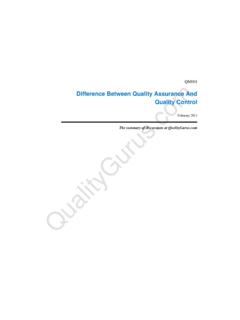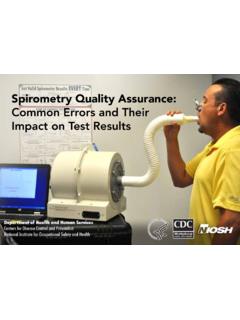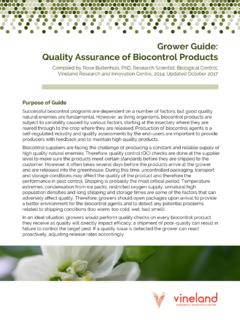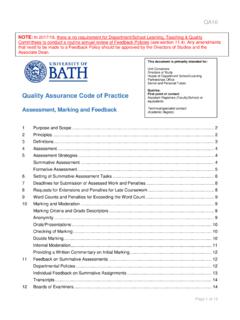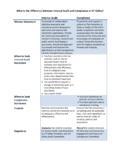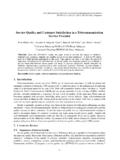Transcription of FAO ANIMAL PRODUCTION AND HEALTH
1 ManualISSN 1810-111914 FAO ANIMAL PRODUCTION AND HEALTHE very sector of the livestock industry, the associated services and the wellbeing of both animals and humans are influenced by ANIMAL feeding. The availability of accurate, reliable and reproducible analytical data is imperative for proper feed formulation. Only reliable analysis can lead to the generation of sound scientific document gives a comprehensive account of good laboratory practices, quality assurance procedures and examples of standard operating procedures as used in individual specialist laboratories. The adoption of these practices and procedures will assist laboratories in acquiring the recognition of competence required for certification or accreditation and will also enhance the quality of the data reported by feed analysis laboratories.
2 In addition, ensuring good laboratory practices presented in the document will enhance the safety of the laboratory workers. The document will be useful for laboratory analysts, laboratory managers, research students and teachers and it is hoped that it will enable workers in ANIMAL industry, including the aquaculture industry, to appreciate the importance of proven reliable data and the associated quality assurance approaches. An additional effect of implementing and adopting these approaches will be strengthening of the research and education capabilities of students graduating from R&D institutions and promotion of a better trading environment between developing and developed economies. This will have long-term benefits and will promote investment in both feed industries and R&D assurance for ANIMAL feed analysis laboratoriesQUALITY assurance FORANIMAL FEEDANALYSIS LABORATORIESFAO ANIMAL PRODUCTION AND HEALTHFOOD AND AGRICULTURE ORGANIZATION OF THE UNITED NATIONSRome, 201114manualQUALITY assurance FORANIMAL FEEDANALYSIS LABORATORIESJim Balthrop, Benedikt Brand, Richard A.
3 Cowie,J rgen Danier, Johan De Boever, Leon de Jonge,Felicity Jackson, Harinder Makkar and Chris PiotrowskiCover photographs:Left image: FAO/Giuseppe BizzarriCentre: FAO/Ishara KodikaraRight image: FAO/Jon SpaullFAO ANIMAL PRODUCTION AND HEALTHFOOD AND AGRICULTURE ORGANIZATION OF THE UNITED NATIONSRome, 201114manualQUALITY assurance FORANIMAL FEEDANALYSIS LABORATORIESJim Balthrop, Benedikt Brand, Richard A. Cowie,J rgen Danier, Johan De Boever, Leon de Jonge,Felicity Jackson, Harinder Makkar and Chris PiotrowskiThe designations employed and the presentation of material in this information product do not imply the expression of any opinion whatsoever on the part of the Food and Agriculture Organization of the United Nations (FAO) concerning the legal or development status of any country, territory, city or area or of its authorities, or concerning the delimitation of its frontiers or boundaries.
4 The mention of specific companies or products of manufacturers, whether or not these have been patented, does not imply that these have been endorsed or recommended by FAO in preference to others of a similar nature that are not views expressed in this information product are those of the author(s) and do not necessarily reflect the views of 978-92-5-107050-5 All rights reserved. FAO encourages reproduction and dissemination of material in this information product. Non-commercial uses will be authorized free of charge, upon request. Reproduction for resale or other commercial purposes, including educational purposes, may incur fees. Applications for permission to reproduce or disseminate FAO copyright materials, and all queries concerning rights and licences, should be addressed by e-mail or to the Chief, Publishing Policy and Support Branch, Office of Knowledge Exchange, Research and Extension, FAO,Viale delle Terme di Caracalla, 00153 Rome, Italy.
5 FAO 2011 Information for users of this ManualShould you face any problem in using methods described in this manual or have a query regarding a method, you may contact experts listed in the FAO Network of Experts: citationFAO. 2011. quality assurance for ANIMAL feed analysis laboratories. FAO ANIMAL PRODUCTION and HEALTH Manual No. 14. vAuthors viiAcknowledgements viiiGlossary of Terms ixIntroduction 1 Part IQuality assurance procedures and good laboratory practices 3 Setting up a quality laboratory system 5 quality and quality control systems 5 quality assurance purpose and guidelines 6 Laboratory organization and responsibilities 7 Personnel training and qualification 8analytical procedures Selection and verification 8 Standard Operating
6 Procedures (SOPs) 9 Equipment maintenance and service 10reporting analytical data 11accuracy and reference samples 12 Precision and blind double samples 12traceability of results 14 Proficiency testing (external quality assurance ) 14 Controls charts Statistical process control 15 Documentation and control of documents 16 Laboratory safety 18audits/Corrective actions/Management reviews 18 quality procedures 21 Validating new methods 21 Qualifying (training) laboratory analysts 27reagents and chemicals 29 Outlier test 31 Laboratory quality audit checklist 32receiving laboratory samples 40 Handling and preparation of feed samples 42 Use of balances 47ivUse of pipettes 51 Operation of pH meter 54 Operation of spectrophotometer 55 Laboratory water 57 Laboratory glassware cleaning procedures 58 Laboratory safety 61 General procedures Correct use of laboratory equipment 68 Part IIAnalytical section 79 Analytical procedures 81 Introduction 81 Dry matter 83 Crude ash 86ash insoluble in hydrochloric acid 88 Nitrogen and calculation of crude protein Kjeldahl 90 Nitrogen and calculation of crude protein Combustion 93 Crude fat Ether extract 96 Crude fibre Filtration method 98 Neutral Detergent Fibre (NDF)
7 Filtration method 101acid Detergent Fibre (aDF) and Lignin (aDL) Filtration method 103 Starch Enzymatic 106reducing sugar Luff schoorl method 110 Gross energy 115 Volatile Fatty acids (VFa) in silage Gas chromatography 118 Lactic acid in silages Enzymatic method 121 Urea Spectrophotometric method 123 Elements aaS 125 Calcium Spectrophotometric method 130 Phosphorus Spectrophotometric method 132 Chlorine titration method 134aflatoxins HPLC method 137 Fumonisins HPLC method 144 Zearalenone (ZON) HPLC method 154 Deoxynivalenol (DON) HPLC method 161 Dry matter digestibility in vitro using rumen liquor 167 NIr analysis 172vForewordAnimal feeding impacts on many areas of agriculture: productivity, environmental emissions, water pollution, land use, ANIMAL HEALTH , product safety, product quality and ANIMAL welfare. Every sector of the livestock industry, the associated services and the wellbeing of both animals and humans are influenced by ANIMAL feeding.
8 Proper ANIMAL feeding is the sup-ply of a diet balanced in all nutrients and free from deleterious components, at a level that meets the PRODUCTION objective, considering the ANIMAL s physiological state, and generates ANIMAL products that are safe for human consumption. The availability of accurate, reliable and reproducible analytical data is imperative for proper feed formulation. Also only reliable data can lead to the generation of sound scientific received from international experts visiting ANIMAL nutrition laboratories, engaged in analysing feeds and feed ingredients in developing countries, highlight the need to strengthen quality assurance systems in these laboratories. As suitable quality assurance systems are not in place, the laboratory personnel are unable to evaluate the quality of the data being generated. Various ring tests conducted in developed countries have shown an unacceptable variation for some analytes being routinely determined in feed analysis labo-ratories.
9 Similarly evidence received from the feed industries in developing countries on the reliability of feed analysis data suggests this is inconsistent, therefore, an urgent need to produce a document covering quality assurance systems was realised. The current document has been developed and prepared by a panel of nine experts. The emphasis is on the basic analysis used for determining the nutritional value of feeds and feed ingredients. The document gives a comprehensive account of good laboratory practices, quality assurance procedures and examples of standard operating procedures as used in individual specialist laboratories. The adoption of these practices and procedures will assist laboratories in acquiring the recognition of competence required for certification or accredi-tation and will also enhance the quality of the data reported by feed analysis laboratories.
10 In addition, ensuring good laboratory practices presented in the document will enhance the safety of the laboratory workers, protect the environment from laboratory-discharged pol-lutants and increase the efficiency of laboratories. The document will also provide a strong base for laboratories on which they can develop a system which will meet the requirements of international standards. It will be useful for Laboratory Analysts, Laboratory Managers, research students and teachers and it is hoped that it will enable workers in ANIMAL industry, including the aquaculture industry, to appreciate the importance of proven reliable data and the associated quality assurance approaches. This document, through increasing skills and knowledge of laboratory personnel and researchers, will also result in quality assurance systems becoming an integral part of the functioning of a feed analysis laboratory.










